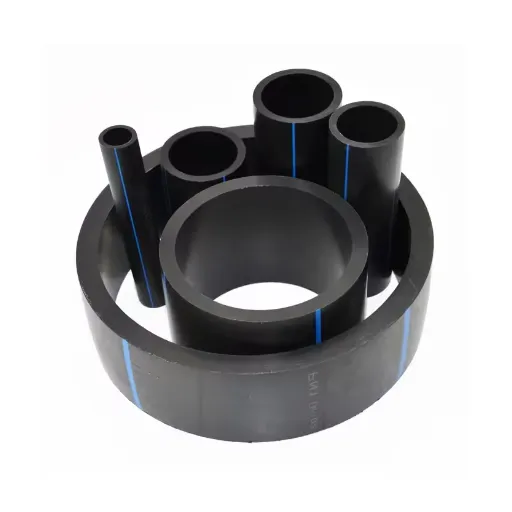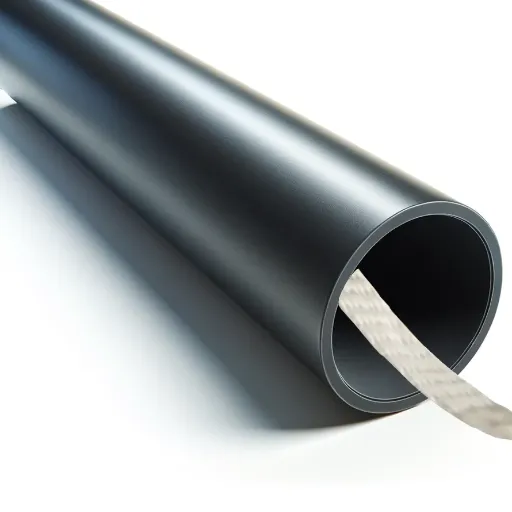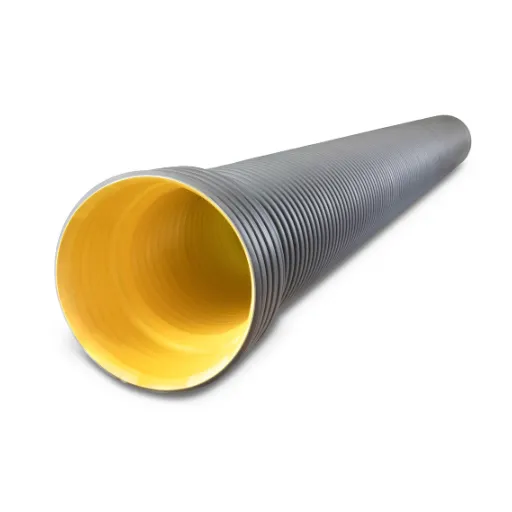High-density polyethylene (HDPE) water service pipes, when used in the potable water system, offer adequate service with high reliability. The pipes are well known for their durability, flexibility, and resistance to high environmental stress. In this guide, the primary focus is on the 200 PSI black HDPE pipes which are constructed for use in high pressure potable water systems. In this guide, we will investigate the main technical characteristics of these pipes, their advantages and their adherence to standards and regulations. Furthermore, we will look into the production techniques, the highest achievable and recommended standards for installation, as well as maintenance norms for the pipes for optimal service and their lengthy service life. This guide will enable an engineer, contractor or water system operator to appreciate the impressive multi-faceted features of HDPE water service pipes.
What is HDPE Water Service Pipe and How Does It Compare to PVC?
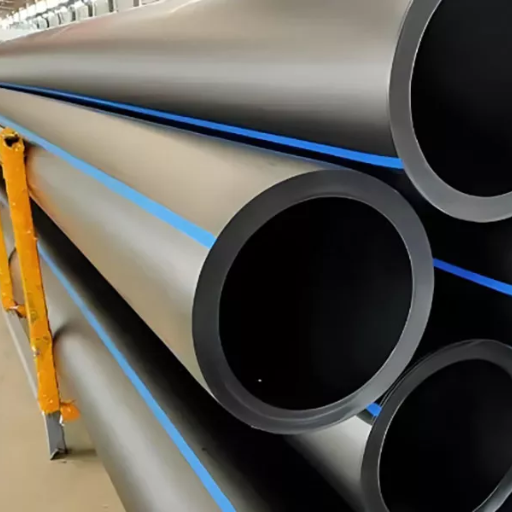
Water Service Pipes made of High-Density Polyethylene (HDPE) are highly durable and flexible pipes made of thermoplastic. HDPE pipes are preferred for drinking water systems due to their high strength-to-density ratio that increases their resistance toward environmental stress cracking along with corrosion and chemicals. Compared to Polyvinyl Chloride (PVC) pipes, HDPE is more flexible, allowing greater movement in soils during seismic activity hence, performs better. In comparison to PVC, HDPE is less vulnerable to leaks and fractures and, therefore, has a longer service life. Though rigid, PVC is more affordable in some cases. While both resources are acceptable for use in the water sector, their performance characteristics differ due to the conditions of the specific projects.
Understanding High-Density Polyethylene (HDPE) Pipe
Pipes made of High-Density Polyethylene (HDPE) are known for their outstanding flexibility, toughness, and ability to adapt for many uses and applications. It is this flexibility that makes HDPE pipes to bear bending or circumferential strain without rupturing, and so such pipes can be installed in areas where the soil is not stable or in regions prone to earthquakes. Moreover, the non-corrosive nature of the material enhances its sustainability even in substandard settings and its high resistance to environmental stress cracking enables superior performance over extended periods.
The best characteristic of the HDPE pipes is their ability to be leak-proof. Create- a method of obtaining helical pipe by fusing pipes – allows the use of heat fusion for joining HDPE pipes, thus allowing monolithic systems to be formed. Mechanically joint systems have an increased likelihood of leaks due to the many points where water may escape and be lost, so the elimination of these in HDPE pipes makes them much more resistant. Furthermore, HDPE pipes are resistant to many different types of chemicals, enabling them to be used for transporting potable water, wastewater, and other industrial fluids while remaining untouched by the liquids within them.
Furthermore, Extreme temperature fluctuations are more easily sustained by HDPE, with UV resistance built in extending the service life of the material in areas where it is harshly tested. The ease of transport as well as the ease of installation drastically lower the cost incurred, especially when working with a material that will require a bulk investment compared to other materials such as PVC. Because of the high regulatory expectations for industry standard compliance and the extreme conditions for adaptability, HDPE pipes have become widely accepted for use in water distribution, gas transfer, sewage systems and even in industrial piping projects.
HDPE vs. PVC: Which is Better for Water Systems?
It is my opinion that, in the majority, of situations HDPE will outperform PVC when evaluating them for water services owing to its strength, flexibility, and resistance to environmental conditions. In comparison to other types of pipes, HDPE pipes are rated at higher pressures and perform well in extreme hot and cold temperatures so they can easily be installed in situations where they are required for long periods. On top of that, HDPE pipes are reliable because they can endure exposure to chemicals and movement in the earth. While PVC is significantly cheaper initially and straightforward to install in less complicated situations, it is less flexible and certain factors can render it more brittle over time. In cases where durability and flexibility are of utmost importance, I suggest using HDPE instead of PVC.
Benefits of HDPE Pipe for Potable Water Applications
Because of their strength, security, and extraordinary service life, HDPE pipes are extensively utilized in water supply systems. The vital benefits include:
Immunity to Rust
HDPE pipes unlike metal pipes, are naturally immune to rusting and chemical corrosion, which plays a pivotal role in protecting water quality and averting long term damage.
Seamless Connections
To inhibit leakage and reduce water loss, HDPE pipes use a technique called heat fusion welding joints. This technique significantly increases the robustness of the piping structure.
Bendable and impact resistant
HDPE pipes offer flexibility due to their elasticity of around 0.8 GPa. This property allows the pipes to endure ground movement, earthquakes, and pressure surges without cracking or failing. Moreover, the pipes are incredibly durable in harsh conditions.
Durability
Due to reduced repair and replacement needs, HDPE pipes offer an economical long term solution. With a lifespan of over 50 years under optimal conditions, these pipes are ideal due to their low maintenance.
Health Safe
To obtain proper certification for health and safety compliance, HDPE pipes are subjected to multiple tests. For instance, NSF/ANSI 61 ensures that the pipes do not leach harmful substances into the water, confirming their safety for drinking.
The internal surface of HDPE pipes (Manning coefficient of 0.009) is smooth, which leads to minimum friction. This ensures the maximum flow of water, which ultimately saves energy costs.
With a temperature as low as 0°F to as high as 140°F (-18°C to 60°C), and a pressure of up to 250 psi rating, HDPE can perform well depending on the pipe’s SDR ( Standard Dimension Ratio).
By merging deformability, harsh condition resistance, and relevant performance indicators, HDPE becomes the best material for drinking water supply systems.
How to Install HDPE Water Service Pipe: A Step-by-Step Guide
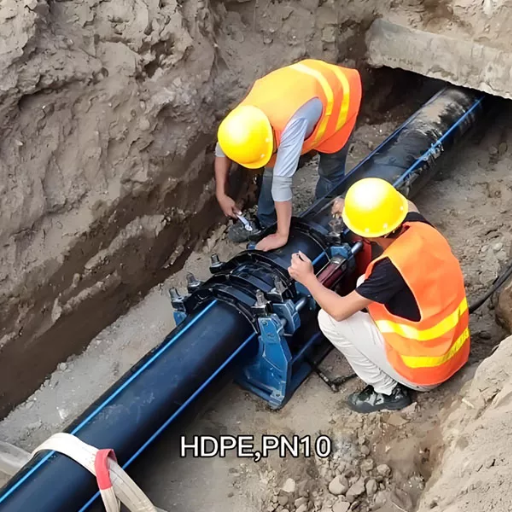
Step 1: Collect All the Necessary Materials
Make sure you have all the necessary equipment and materials with you such as FUSION PIPES like HDPE pipes, pipe fittings, pipe cutters, fusion tools like butt electrofusion, and more along with relevant safety equipment. Also, ensure that the SDR and the pipe diameter are suitable for the installation need.
Step 2: Clean the Area Selected For the Installation
Remove all clutter from the installation site, and appropriately adjust trench depth and width per region code. For underground installations, the trench should give enough buffer so the pipe is not put under any stress. The bedding should be made of stable compacted soil or sand so the pipe can rest securely.
Step 3: Prepare and Cut the Pipe
Take a pipe cutter, and cut the HDPE to the desired length. Always check the edges to guarantee that they are square and clean. If fusion joining is needed, make sure to thoroughly clean the edges of the pipe so there is no grease, moisture, or dirt.
Step 4: Joining of Pipes
Attach the pipes using the preferred method such as butt fusion or electrofusion. Normally, it is best to align the pipe segments slightly better so the connection is secure. The manufacturer’s instructions need to be followed properly on how much and what should be applied during heating, pressure, and cooling time to ensure strong joints that are also leak-proof.
Step 5: Pipes Installation and Placement
While the piping pieces are being fitted, exercise care to place each piece properly in the available trench such that there are no unnecessary bends or stress on the pipe segments. If required, use restraints during the backfilling process to hold the segments in place.
Step 6: Testing for Leaks in the System Connections.
Employ hydrostatic or pneumatic pressure testing to check for any leaks in the pipe system. Undertake the tasks as per the local regulations on the test pressure and the duration of the test.
Step 7: Final Steps Rough Emplacement of the Pipe Trench
Fill the trench using the appropriate material in a stepwise manner and compress after each step to avoid settling. Do not use heavy or sharp objects which can puncture the piping system.
If these steps are followed thoroughly, you can guarantee the proper and long lasting installation of the HDPE water service pipes.
Proper Installation Techniques for HDPE Pipe
It is paramount that ideal techniques of joining are applied to prevent leaking connections and to guarantee the integrity of the HDPE pipe systems. The most common joining techniques are as follows:
Butt Fusion
Butt Fusion is when two ends of HDPE pipes are heated, and then pressed together, forming a joint that is permanent and uniform. The heating plate parameters are as follows:
The temperature: ± 10°F 400°F (Add 5°C 204)
Heating Duration: depends on how thick the pipe wall is (Look at the manufacturer’s guidelines)
Cooling Duration: time under deformation preventing pressure
Electrofusion
Specialized fittings that are built with heating coils incorporated in them are used with this technique. The coils melt the fitting and pipe surfaces, causing them to fuse when an electric current is run through them. The parameters are:
Voltage along with fusion Duration specific to the size of the fitting (Look at fitting specifications)
Pipe end preparation like scraping oxidation off and cleaning.
Compression Fittings
For temporary purposes, compression fittings can tightly seal smaller diameter pipes. It is important to adhere to the tightened torque as per the fitting manufacturer’s instructions.
Pipe Support and Alignment
To ensure an accurate installation, do the following:
Before joining pipes, ensure that they are positioned in a way that prevents misalignments which can adversely affect pipe joints.
Pipes can be fused with the aid of clamps or alignment tools to ensure they stay in the right place, resulting in a well executed job.
For new installations, make sure that pipes are properly supported both during and after with the maximum spacing intervals of 10 and 15 feet being utilized for smaller and larger diameters respectively. These measurements will vary depending on the thickness of the pipes.
Some Major Pressure Testing Parameters
Pressure testing makes sure that the system retains its duties post installation. Commonly utilized parameters for hydrostatic testing include:
Test pressure: A figure set at 1.5 times the operating pressure ought to be achieved without surpassing the pipe’s pressure rating.
Duration of Test: The time interval falls within a scope of 1 to 3 hours as per the standards defined by the local authorities or pipe manufacturers.
The level of pressure drop limit required to pass the test ought not to be higher than 5 to 10 percent depending on the size and metal frame of the pipe.
These techniques and criteria enable a perfect and performance-oriented installation of HDPE pipes. Make sure to check with the relevant installation codes and the special requirements specified by the manufacturer.
Fusing HDPE Pipe for Leak-Free Connections
Leak-free connections through the fusion of HDPE pipe joints can only be achieved if done in a specific manner and having the required equipment. First, I ensure that the pipe ends are properly cleaned, then aligned properly using an approved facing tool to make sure they meet the smooth, even surfaces. Next, I align the elements of a fusion machine to the appropriate levels of temperature and pressure. I pay close attention to the fusion cycle and make sure it complies with the set standards, such as ASTM F2620. Adequate proper cooling time must be set to allow the joint to solidify with no compromise. Following the processes and using certified fusion tools, I managed to provide durable, leak-free connections that correspond to both local codes and performance requirements.
Tools and Equipment Needed for HDPE Pipe Installation
For HDPE pipe installation, I have specialized tools and equipment that help me achieve precision and efficiency. I first start with a deburring tool that is used to cut the pipe, ensuring that the edges are smooth and sharp. I also use an alignment jig or pipe clamps for pipe stabilization and for maintaining fusion alignment.
A fusion or butt welding machine is essential to the process, and I have a specialized one that ensures an even distribution of pressure and heat while maintaining the specific standards of ASTM F 2620. The machine is set to operate at temperatures around 400 to 450 degrees Fahrenheit (204-232), which is the perfect range for HDPE pipes to soften without being damaged. To add to that, I test my machines with a pyrometer before the fusions and check them with a surface thermometer after the process.
With these tools, I can guarantee that the installation meets the highest standards of compliance, and the additional tools let me mark points of alignment, get the precise measurements needed, and wear protective gloves and goggles.
What Are the Durability and Flexibility Advantages of HDPE Water Pipe?
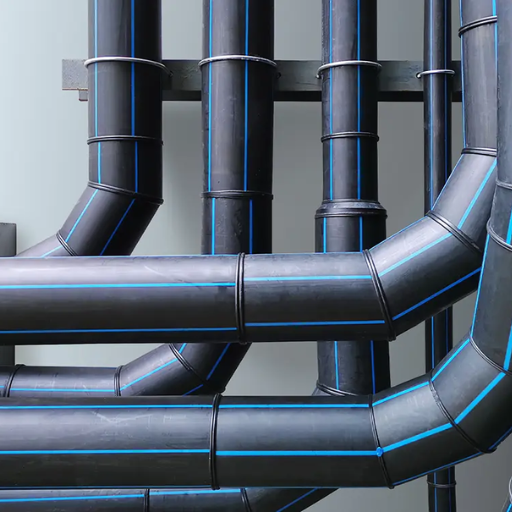
High-Density Polyethylene (HDPE) water pipes are more flexible and durable than standard water pipes, which makes them favorable for numerous uses. Compared to other types, HDPE pipes have superior durability against corrosion, chemical reactions, and environmental conditions. These pipes are so flexible that they can withstand terrain that is difficult to install in, such as areas prone to shifting ground without any breakage. Furthermore, the elasticity of `these pipes enables them to resist impact and vibrations, which makes them difficult to break while being transported or under sudden changes in pressure. All these factors enhance the effectiveness of water distribution systems and lower maintenance and operational costs.
Long Service Life of HDPE Pipe in Water Systems
As per my exploration, I can tell that HDPE pipes generally have an impressive service life of more than 50 years under normal working conditions. This durability stems mainly from the pipes’ excellent chemical and corrosion properties which resist material degradation. Moreover, the flexibility of HDPE also serves the purpose of minimizing damages due to environmental stresses such as soil movement or freeze thaw cycles, which further enhance the pipes’ life. Because of these properties, the use of HDPE pipes in water distribution systems is significantly cost-effective and dependable due to less frequent repairs or replacements.
Resistance to Corrosion and Chemical Exposure
Unlike traditional metal piping, HDPE does not rust, rot, or corrode when exposed to water, chemicals, or various pH levels. This non-reactive nature ensures compatibility with corrosive industrial applications. These pipes not only demonstrate superior corrosion resistance but also withstand harsh chemical alters. For this reason, HDPE pipes are the best choice for such environments. Additionally, the unique internal architecture of the pipes increased the efficiency and reliability of the HDPE piping system as scaling and deposit buildup was significantly reduced. These properties enable HDPE pipes to withstand structural integrity and performance under extreme conditions.
Flexibility and Impact Resistance of HDPE Pipe
Another advantage of HDPE (high-density polyethylene) pipes is their adaptability concerning the flexibility of the pipes themselves. This becomes very useful in situations where dynamic loads need to be sustained or in adverse ground situations. The minimum bending radius of HDPE pipes is 20 – 25 times their outer diameter at a minimum, so they can sustain a fair amount of ground movement without structural deformation. This is why HDPE pipes are most sought after in areas that experience seismic activity or ground settlement.
Moreover, the resilience of impact that HDPE pipes tolerate is commendable. Such pipes can endure impacts even under the temperature of -40 degrees Fahrenheit / -40 degrees Celsius. Further broadening the range of durability to extreme weather conditions, seamless impact damage tolerance becomes a property of HDPE because of its intrinsic toughness. Without declaring outright superiority, these attributes confer upon the pipes a clear choice for industrial, municipal, and construction applications.
What Pressure Ratings and Sizes Are Available for HDPE Water Service Pipe?
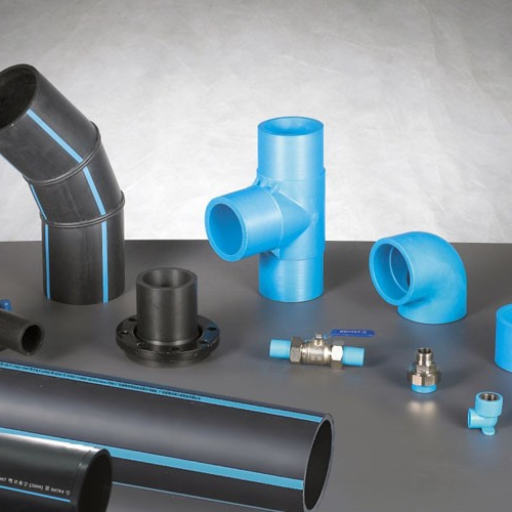
The selected medium from among the most used service pipes in the construction of any underground infrastructure is the HDPE water service pipes. These pipes have different PSI ratings which along with sizes allow for a variety of project specifications. The pressure ratings usually are between 63 psi and 335 psi, varying based on the thickness of the pipe walls and the SDR value. The diameter size of the pipe ranges from ¾ inches to 63 inches. Because of this flexibility, these HDPE pipes are suitably used for the low-pressure systems of pipes used at homes on the other hand also meet the needs @nd high-pressure systems of pipes used for industrial and municipal services.
Understanding SDR 11 and 200 PSI Ratings
SDR11 designates the Standard Dimensioned ratio of the depth of a pipe which is regarded as the measure of the outside diameter of the pipe over the thickness of the wall. SDR11 usually describes a thicker wall compared to other SDR measures which can withstand greater pressure. The HDPE pipes with SDR 11 rate can sustain a pressure of 200PSI at a temperature of 73˚F (which is approximately 23˚C). Hence, these pipes can be used under medium to high pressure for the service of water.
Key parameters for SDR 11 HDPE pipes include the following:
Material: Usually manufactured from PE4710 resin for better durability and performance.
Pressure Rating: 200PSI(23.2 KPSI) at the temperature of 73°F (23°C) which must be reduced for high temperatures.
Pipe Diameter Range: Diameters ranging from ¾ inch to 48 inches are available but limited to the range provided by the manufacturer.
Temperature Derating Factors: Might be reduced by 10% for every 10˚F rise above 73˚F. This has to be factored into during the design of the system.
The unique combination of strength and flexibility of these SDR11 pipes makes them particularly useful for municipal water supply systems, pressurized irrigation systems and industrial fluid transfer. When designing a system, attention to pipe size, operating conditions and temperatures must be paid to guarantee dependability and safety.
Common Diameters and Lengths of HDPE Water Pipe
HDPE water pipes are produced in differing diameters and lengths depending on the target market. Generally, the smaller diameter pipes are ½ inch and commonly used at residences or other low demand systems, whereas 65-inch pipes are used in industrial or municipal projects. The standard supply lengths are typically available in 20 and 40 foot long straight sections of pipes and in continuous coils for smaller diameter pipes up to 6 inches. These smaller length pipes can be several hundred feet in length, which aids in reducing joints and increasing flexibility during installation. Jointly these features help implement the more advanced trenchless installation method and provide continuous piping. System requirements, site conditions, cost, and performance mandates all check the choice of diameter and length of the pipes.
Choosing the Right HDPE Pipe Size for Your Project
To determine the appropriate size of solid wall HDPE pipes used in construction, I consider some key parameters such as the system flow rate, working pressure, and site conditions. For example, I set the pipe diameter to the required flowing capacity so that it can handle peak flow rates without excessive turbulence or excessive pressure loss. Likewise, if the system involves high load pressures, I check the pipe Pressure Rating PR or the Standard Dimension Ratio SDR which is mostly SDR 11 or SDR 17 for medium to high pressure. Moreover, site conditions like soil type, how the pipes are installed, and the range of temperatures also affect the pipe size and thickness selection. My approach allows me to define the performance characteristics of the pipe to achieve reliable, durable and economical system performance.
How Does HDPE Water Pipe Perform in Extreme Temperatures and UV Exposure?
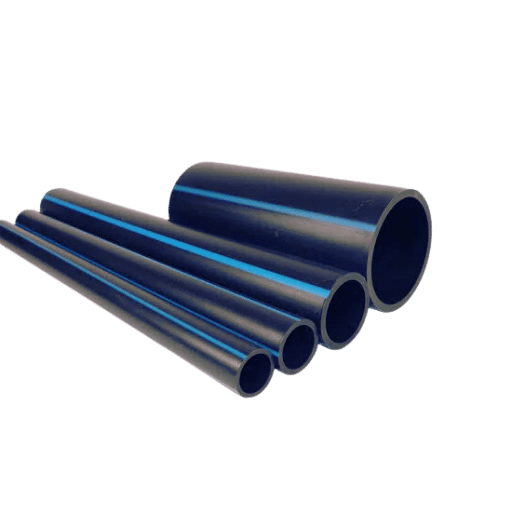
The unique material composition of the High-Density Polyethylene pipes for water transport – HDPE pipes – makes them outperform in extreme temperatures and even UV exposure. The flexibility retention and high tensile strength of poly-ethanol is maintained within a range of -40°F to 140°F giving it the ability to flex in both freezing and high heat applications. Along with UV stabilizers, polyethylene pipes exhibit incredible strength and functionality. Even when exposed to extreme UV radiation, these pipes demonstrate a high resistance to degradation while all other HDPE pipes without stabilizers cannot withstand these environments. HDPE pipes further enhance their resilience by carefully choosing the materials and following industry compliance standards which always ensures quality performance.
Temperature Range for HDPE Pipe Performance
Operating in environments with variable temperatures is one of the many advantages of HDPE pipes. The material has a rating for long-term use between -40F (-40C) and 140F (60C), and most of the time, these extremes do not impact the integrity of the product. The pipes can sustain short-term exposure of around 176F (80C) based on the grade and application of the specific pipe. At freezing temperatures, HDPE material does not lose its properties including impact resistance and flexibility, which helps it sustain cracking or other forms of breaking. For installation and physical use of the pipes, adherence to the manufacturer’s specifications on temperature and operational instructions is necessary for optimal performance of the material. There are also industry standards, for example, ISO 4427 and ASTM D3350, that outline the material requirements for HDPE to set minimum performance and safety levels under changing temperatures.
UV Resistance of Black HDPE Pipe
The purpose of carbon black addition of about 2 to 3 percent is who confinement of Ultraviolet (UV) radiation harm. The black HDPE pipe is manufactured for maximum UV radiation protection. This additive serves as a stabilizer that absorbs and dissipates harmful UV rays, consequently preventing ecological harm for an elongated period of in the sun. Black HDPE’s mechanical properties, structural composition, and lifespan are retained even when subjected to long hours of outdoor usage. Not all pipes are black withstanding ultraviolet rays possess insulating qualities. While black HDPE pipes do, there are standard operating procedures that must be adhered to for effective performance and longevity. As these pre-installed HDPE pipes are sophisticated, maintenance abnormalities need to be monitored at regular intervals. In every case, it is prudent to consult the producers to avoid discrepancies when the product specifications are divulged.
HDPE Pipe Performance in Freezing Conditions
Water at 0 degrees, expands and freezes. This phenomenon makes it necessary for pipes to be fissure-less; which, fortunately, HDPE pipes are, unlike certain materials. Are designed to perform exceptionally well in freezing conditions. On top of this, they are flexible and high-impact resistant. To enable HDPE, and subsequently, the pipes made from it, to withstand the extreme conditions, proper installation is necessary, such as maintenance of adequate burial depth below frost lines and insulation. Frost causes a great amount of stress on objects, whereas HDPE pipes elongate under strain, allowing for the material to perform under winter without the risk of demolishing the pipes. Consulting the manufacturer is required to ensure the suitability of specific manufactured pipes to withstand Extreme weather changes.
References
Frequently Asked Questions (FAQ)
Q: What is an HDPE water service pipe?
A: HDPE (High-Density Polyethylene) water service pipe is a type of plastic piping used for transporting water. It is known for its durability, versatility, and ability to be installed in a wide range of applications, including ranch water projects and gas distribution.
Q: Why are HDPE pipes preferred over other materials?
A: HDPE pipes are preferred due to their durability and versatility. They have a service life of over 100 years and joints that eliminate potential leak points, making them a preferred choice for many piping applications.
Q: What are the advantages of using WL Plastics HDPE pipes?
A: WL Plastics HDPE pipes offer several advantages, including excellent chemical resistance, ductile nature, and the ability to handle thousands of feet of pipe without the need for fittings. This makes them highly suitable for various projects.
Q: How does the chemical resistance of HDPE pipes benefit water service applications?
A: The chemical resistance of HDPE pipes makes them ideal for water service applications as they can handle a wide range of liquids and environmental conditions without deteriorating, ensuring a long service life.
Q: Are shipping fees applicable when purchasing HDPE pipes?
A: Yes, shipping fees may apply when purchasing HDPE pipes, depending on the supplier and the quantity of pipe material ordered. It is advisable to check with the supplier for specific shipping fee details.
Q: What are the typical applications of HDPE water service pipes?
A: HDPE water service pipes are used in various applications such as gas distribution, ranch water projects, and directional drilling, due to their outstanding durability and versatility.
Q: How do HDPE pipes compare to ductile iron pipes?
A: HDPE pipes are more lightweight and flexible compared to ductile iron pipes, allowing for easier installation and handling. They also have superior chemical resistance and longer service life, making them a suitable alternative.
Q: Can HDPE pipes be used for pipe bursting projects?
A: Yes, HDPE pipes are suitable for pipe bursting projects as they can be installed without the need for extensive excavation, reducing installation time and costs.
Q: What diameters are HDPE pipes available in?
A: HDPE pipes are available in various diameters, allowing them to be used in a wide range of applications, from small residential water lines to large municipal projects.
Q: How does the ability to be installed without fittings benefit HDPE pipe projects?
A: The ability to install HDPE pipes without the need for fittings reduces the risk of leaks and simplifies the installation process, making them a cost-effective and reliable choice for water service projects.



